
Brazil occupies half of the landmass of South America. It is the fifth largest country in the world in both population and landmass. It has 7,400 km of coastline – no other nation can boast as much continuous coastline.
It also shares over 15,700 km of land borders with every South American country except Chile and Ecuador.
The country has no desert, high-mountain, or arctic environments but instead has a wide range of tropical and subtropical landscapes, including wetlands, savannas, plateaus, and low mountains.
Brazil contains most of the Amazon River basin, which has the world’s largest river (by volume) system and the world.
Brazil has the most-extensive virgin rainforest on the planet with around 60% of the Amazon Rainforest being in Brazil.

The Brazilian population sits at around 214 million and their people are made up of the original indigenous tribes along with a mix of Portuguese, European, and African ancestries.
Lets get this straight right up front. Brazil is huge and the thought that we have seen any more than a speck of it is just ludicrous. Our time has been severely limited and we are popping in and out of tourist hotspots and the odd random location. Everything here is a teaser of more to come. But the overwhelming opinion from what will follow is that this place is amazing and must be explored more fully.

Brazil is considered one of the most biodiverse places on the planet. Every year, around 700 new plant and animal species are discovered (mostly in the Amazon rainforest). It is regarded as a ‘megadiverse’ country, featuring about 4,000 plant species, 9,000 vertebrates, and 120,000 invertebrates.
The thing that Brazil is probably most known for is however Carnival. This festival takes place every year at the beginning of Christian Lent (the Friday before Ash Wednesday to be precise). It is hosted in Rio de Janeiro and attracts about six million participants. The festival has street-wide celebrations, ornate parade floats and people dressed in elaborate costumes. Rio’s first Carnival was held in 1723.





Fortaleza
Fortaleza (or fortress) is Brazil’s 4th largest city (with about 4 million people) that sits in the Northeast of the country. The main claim to fame of Fortaleza is as a major domestic tourist destination hub. At this stage, it does not draw large numbers of international tourists but is a Mecca for the locals.


Hopping off the boat we got sick of the idea of haggling with the overpriced taxis that infested the port. The taxis were trying to charge $20-30USD (96-144 Brazilian real) to get a lift to town. So we did our usual and walked out of the port area to get an Uber.
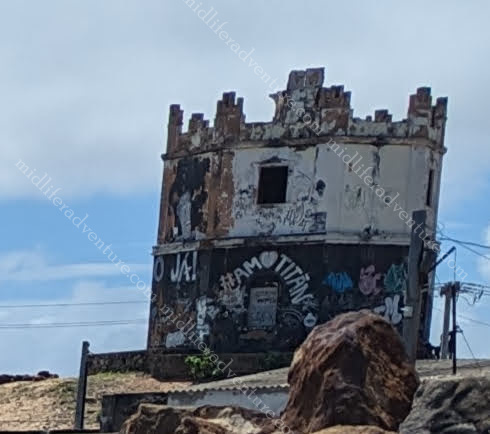
Jill’s map showed that there was a lighthouse just outside the gate so we aimed for that.
At this point, we were met with a police blockade telling us that the nearby neighbourhood was too dangerous to walk through and that they would only let us leave in a vehicle.
We met another couple who wanted to walk along the nearby beach but they were also discouraged due to the perceived danger. We also met a Canadian couple who were equally as eager to explore but equally oblivious as to where to go.
So we perched on the side of the road and ordered our Uber. Having no idea where to go we aimed for the Cathedral, figuring it would be pretty central and we could roam about from there. So a 37 real ($7.70) Uber ride and we were delivered direct to St. Joseph’s Cathedral.








This is the main Cathedral in town and can fit up to 5000 inside. The main towers reach 75 meters. Perched on the top of the hill it is a mere block or so from the circular Fortaleza Central Market (Mercado Central de Fortaleza). Originally a meat and fish market, it has now been converted to a crafts market with about 500 shops.




The streets around the markets were full of pop-up market stalls with virtually anything you could imagine on offer.



But the main thing about Fortaleza is the foreshore. To the north of the city is a long, scenic and highly accessible Atlantic Ocean. Leaving the Central market I led the way and marched down the road, around the corner and through some pretty dodgy areas until we eventually turned left and found ourselves at the suspect end of the Avenida Beira Mar.
The Avenida Beira Mar is a wide beachfront promenade that runs along the oceanfront. Our entry point was closest to town which was pretty sketchy at best. While the beaches offer emerald green seas, the neighbourhoods were not quite as salubrious. Not quite favelas , but certainly not very tourist friendly.




But the more we walked, the nicer it got. The dodginess eased and the tourist staples started to appear. The Avenida Beira-Mar sidewalk kicked in revealing the expected cafe’s, restaurants, Japanese garden, beach volleyball courts and the rest of the tourist elements. In fact, the range of shoreline activities are almost unending.







We (including the Canadian couple that we met) found ourselves at a funky little beachside cafe that offered good (if tough to understand and communicate with) and cheap service. Really nice, cold, big beers, by the beach and surrounded by cheeky bikinis made for a tough afternoon. Even more so when the bill came back at under $10 for 4 really large beers. Add to this the random lobster and prawn salesman who was offering 3 for $10.



Futuro Beach is one of the most famous beaches in Fortaleza. Stretching for 8km along the city foreshore it is a great beach and the local touts offer fresh lobster, shrimp, crab and fish.
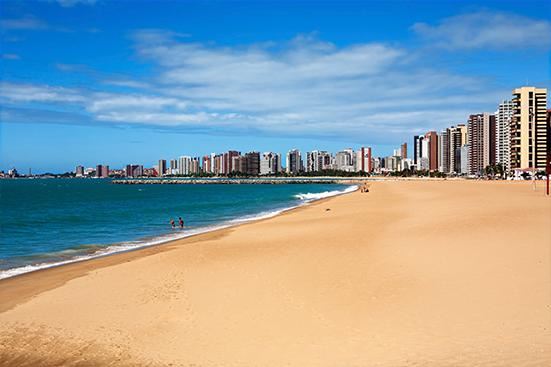
As we walked away from town the beach kept getting better and better. They were obviously setting up for the upcoming New Year’s celebrations and stages, generators and makeshift toilets were all finding their way to the foreshore. We were due back to the boat before 5pm which sadly saw us having to leave the area early.
I got the sense that the area that we were in would be absolutely amazing for sundowner drinks and into the early evening. I would probably stick more to the tourist end rather than the town end but the beach promenade would certainly be the place to be.
The Uber back to the ship was even cheaper and we ended up getting transport in both directions and 4 big beers for less than the cab drivers were charging for a one way fare.
Recife
een quite different. It must be noted however that the military and police presence on every street corner has been extreme. Whether they put on a blitz when a boat arrives or if it is standard is unclear. But we have walked around freely and un-harassed and at no point even felt insecure or uneasy.
We do tend to be alert and aware travellers, we watch our surroundings and do not take unnecessary risks. But so far there has been no point where we have felt threatened or uncomfortable. For those who have been reading along the feeling that we got in the Canary Islands was much more troubling than anything in Brazil so far.
But Recife is a major city. It is famous for its beaches, history, Carnival, arts, the cuisine and of course the cheeky bikinis.
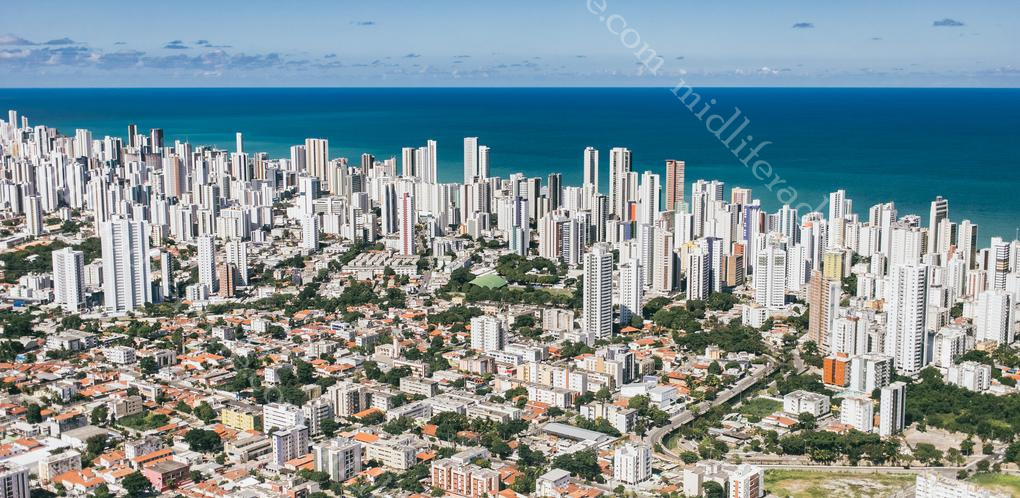
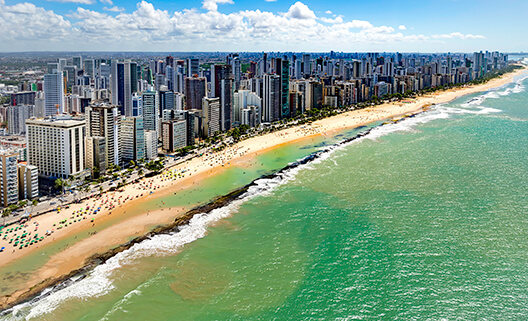
Boa Viagem is by far the most famous of the beaches, stretching for 8 kilometers it is the longest urbanised seafront in Brazil. The nearby coastal reef calms the waves and helps keep the water at 25 °C.
While the beach is amazing, since the mid 1990’s it has been plagued by bull and tiger shark attacks. This started after the building of a new port facility (about 50kms away) that changed the sharks pattern. Between 1992 and 2021, there were 62 shark attacks with 25 fatalities. Some were attacked while swimming in water barely up to their waist. Boa Viagem is so dangerous that lifeguards no longer train on the beach itself.

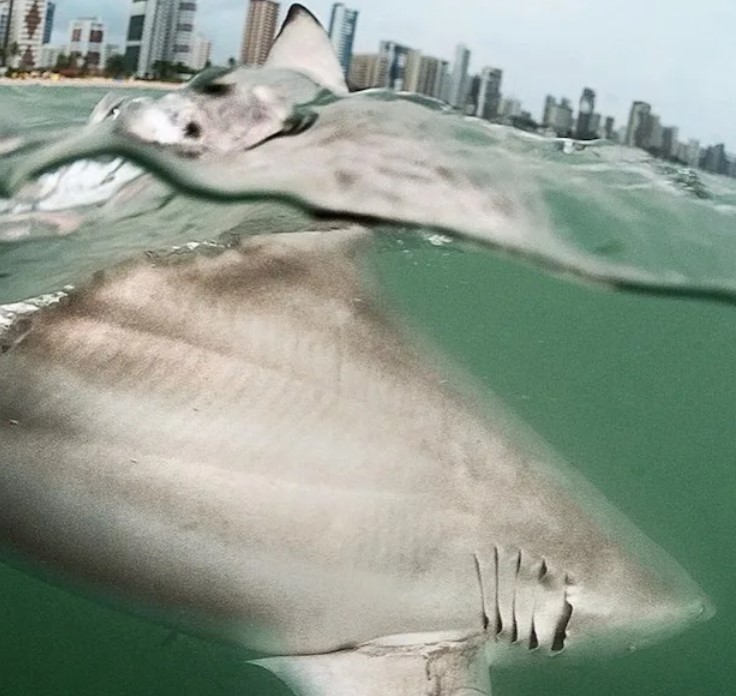
National Geographic photographer Daniel Botelho managed to get a split-level image that showed the shark beneath the surface and the nearby skyline above the surface.
The photo was taken only 50 meters from the shore.
Having read all of this, we chose not to swim. So instead we wandered the streets of town and took in the colonial architecture that was on offer. There were police and military everywhere you looked but at no point was it uncomfortable.












We wandered along the waterfront and broke right, to take in some of the waterways and parks near the ports. We found bridges, statues and a massively cheap way of living. All of the restaurants that we passed had menus showing that the major price was about 22 Brazilian real (about $7).
Not really sure why, but we kept coming across a bunch of 3 meter tall chickens.














Our wander about was possibly not reflective of the others on the boat. We told a group from the boat where we had been and what we had seen and when they tried to replicate, they were turned around and sent back by the police who told them that it was unsafe. My ability to look like a local almost everywhere I go coupled with my size allows me to walk virtually anywhere I want without being approached. Jill just kind of tags along and is also left alone.
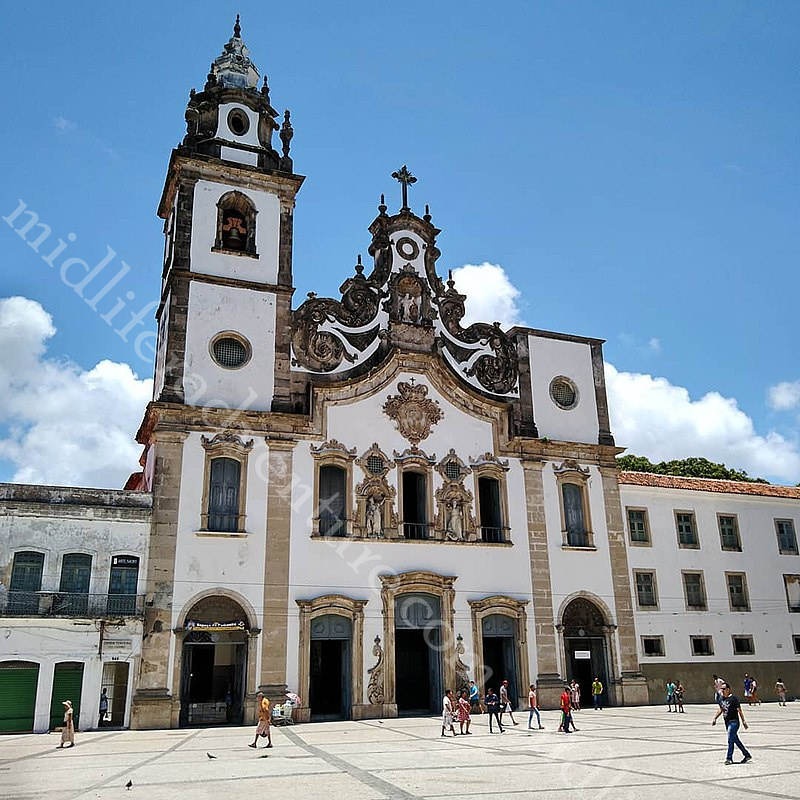
Our meanderings saw us running into the Basílica e Convento de Nossa Senhora do Carmo. This is a church and a convent.
The Basilica started in 1580 by Carmelite friars and in 1654 the Our Lady of Mount Carmel nuns arrived.
The Kahal Zur Israel Synagogue doesn’t look like much from the outside but is OK once you pop your head in.
It is the oldest Synagogue in South America (established in 1636).
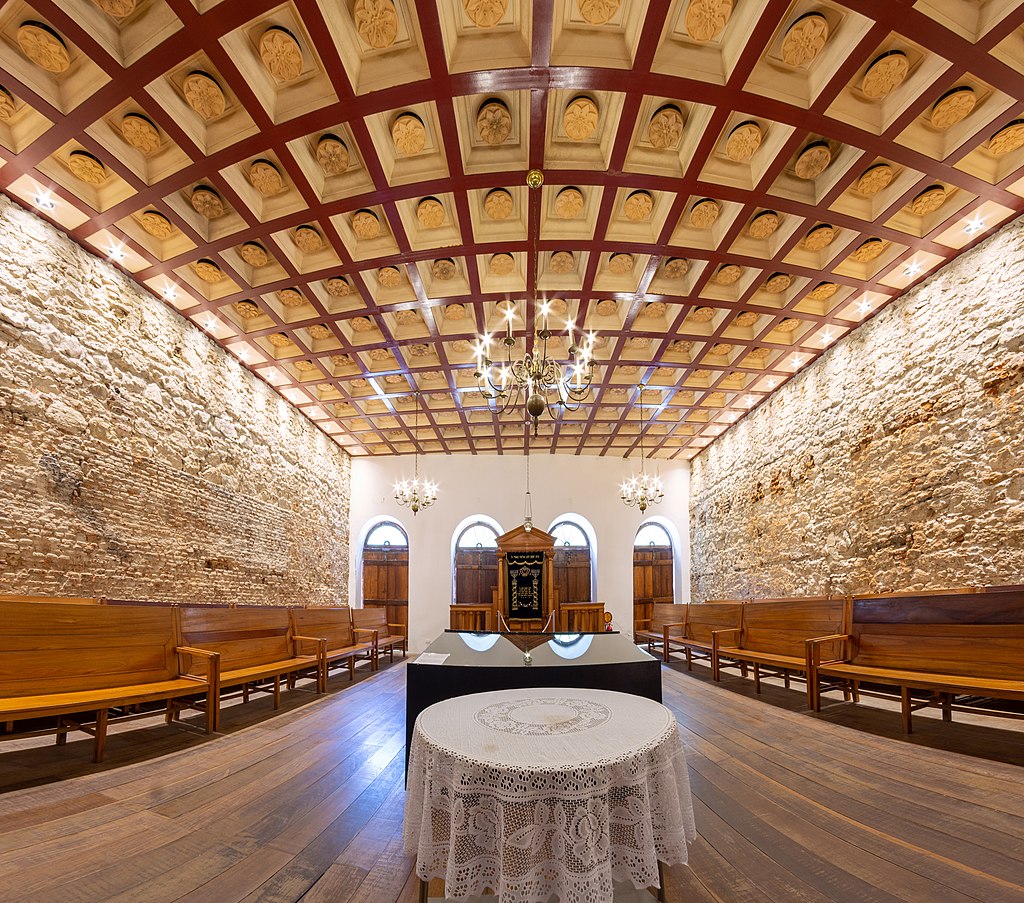
We found the local markets and got to experience life in real neighbourhoods. There were large American Style shopping malls that others on the ship had gone to, but ours was more like the local neighbourhood shops and even included a wet market.



While we never felt threatened or in peril, there was a great deal of overt poverty all through the place. There were lots of people sleeping on the streets, bathing in fountains and using the local parks as their own private laundries.




Recife had a really nice feel to it and we look forward to coming back when time is not so much a factor.





Rio de Janeiro
Well this has been a long time coming and let me say right up front it was worth the wait. Rio de Janeiro couldn’t have been settled in a more beautiful landscape, nestled between the hills and the ocean. They made a definite point of saying that they were hills as they were not tall enough to classify as mountains.
The skyline is dominated by two main peaks that rise from Guanabara Bay. The first is sugarloaf mountain (not a mountain at 396 meters but hey) and the other is Corcovado (still not a mountain at 710 meters) which is the site of Christ the Redeemer.
Our day was mostly grey and overcast, but on occasion the sun peaked out from behind the clouds but then quickly disappeared again.
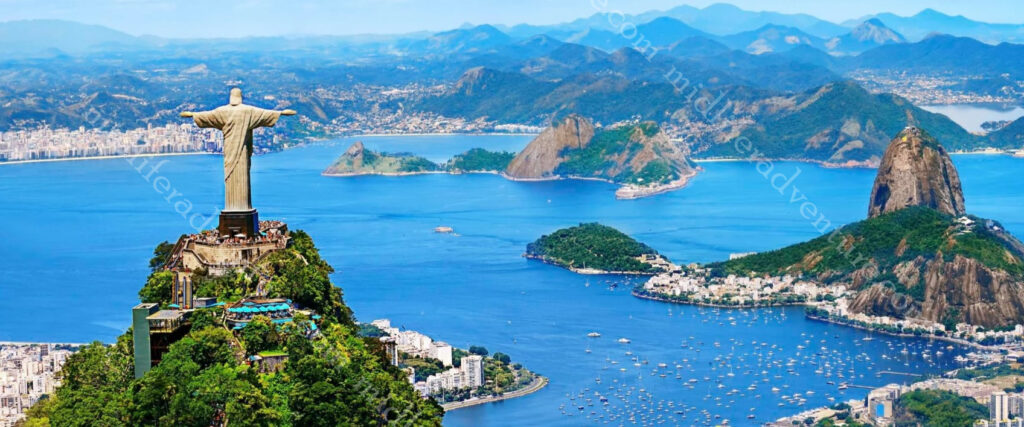
Getting around in Rio de Janeiro proved to be really simple. Our movement was dominated by our tour bus, but a clean and efficient metro system, cheap Ubers and yellow taxis make Rio pretty straightforward to navigate. During daylight hours the streets are safe to walk around on and the beaches have hire bikes that link in with a local mobile app (about $7 for 2 days).
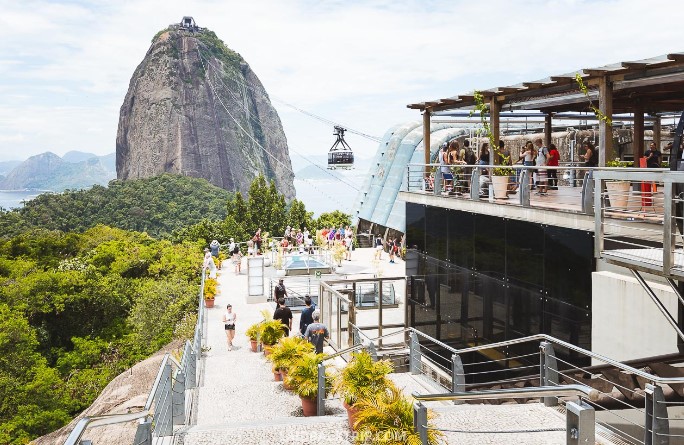
Sugarloaf Mountain (known as Pao de Acucar) is one of the most iconic and sought-after landmarks and top attractions of Rio de Janeiro.
The peak is known worldwide for its cable car, the panoramic views of the city and the infamous Rio beaches (more about these later). It is a huge lump of granite and quartz rising straight out of the water and offers 360 degree views of Rio. It is also a UNESCO World Heritage site.






You have the option of hiking (yeah right) or taking the modern cable car all the way to the top. The hike takes you half way with another cable car taking you the rest of the way.

The obvious next place was to climb the Corcovado mountain to see the Christ the Redeemer statue.
This is possibly one of the most famous views on the planet. You’ve probably seen the picture million times – a giant white concrete statue of Christ the Redeemer overlooking the city of Rio de Janeiro.






The sight is impressive in photos, but the reality is even better. The statue was first conceived in 1920, after World War I, when representatives of the Brazilian republic felt that the country needed a symbol to strengthen their faith again.
To get here we got a bus to the foot of the hill, where you meet up with the funicular railway, which takes you by cog tram, through the forest to the foot of the statue. The tram/train leaves every 30 minutes, and the ride up takes 20 minutes.





The statue is 30 meters tall, standing on an 8 meter pedestal and weighs in at 635 tons and was finished in 1931. The arms of Christ the Redeemer stretch 28 meters wide and the surrounding area has been designated as the Tijuca Forest National Park.




Lets be serious here. You will be but one of thousands visiting here. At any time of day. The place is packed. If your photo editing skills are good or if your framing is perfect or you are super lucky, you may get a nice photo. Otherwise expect there to be a ton of other people. We gave up on the getting to the Sugarloaf lookout from the Corcovado as the number of people was just mind boggling.
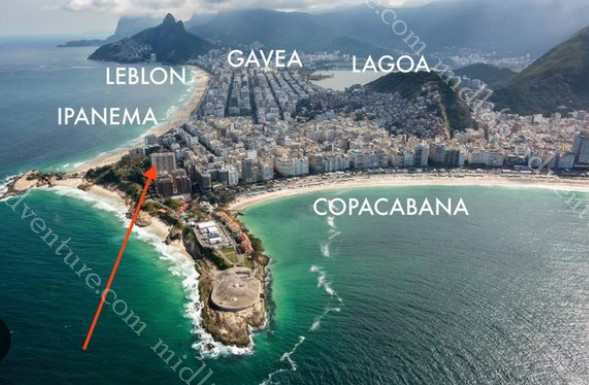
Coming down the mountain (hill) we did the beach loop. Rio de Janeiro is home to some of the most famous beaches on the planet. The main ones are Copacabana, Ipanema, and Leblon (broken up only by Arpoador rock..
Copacabana is one of the most famous beaches in the world. The boulevard was designed by Brazilian architect Roberto Burle Marx and is depicted in postcards – mainly due to the beautiful wide beach and striking patterned pavement. As we were in town on New Year’s Eve, the beaches were more packed than usual and the local authorities were setting up for the New Year’s Celebration. The sheer volume of portaloos being set up was a sight to behold.





Ipanema beach is the next most famous of the Rio beaches popularised by the famous 1960’s bossa nova song the ‘Girl from Ipanema’. If you think that you can visit this beach without hearing this song in either English or Portuguese then you are kidding yourself. The song was written about a real person (Helô Pinheiro) who at the age of 17 inspired the songwriters (Antônio Carlos Jobim and Vinicius de Moraes) by simply walking to the beach.



Leblon Beach flows directly on from Ipanema Beach separated only by a canal and park known as Jardim de Alá or thew garden of Allah. The Canal links the lagoon to the Atlantic Ocean.


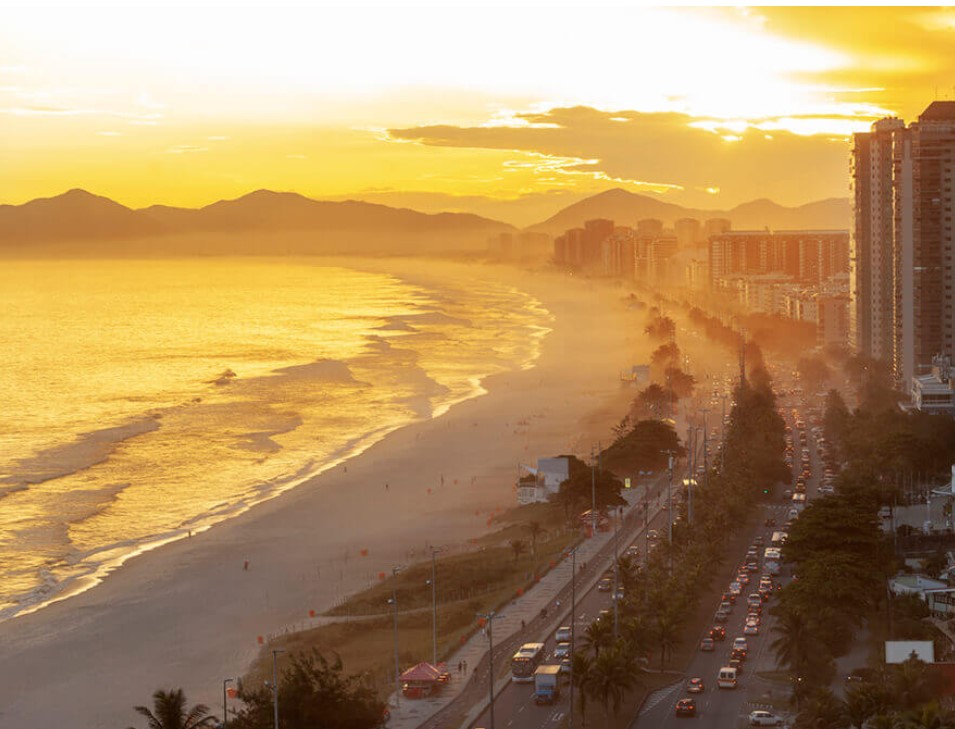
Barra da Tijuca is a bit more off the beaten path but is a suburban beach. It is more American in style with condo’s and shopping malls everywhere you look and was the site of many events during the 2016 Olympics.
Since the Portuguese colonised Brazil in the 16th century, it has been overwhelmingly Catholic. Today Brazil has more Roman Catholics than any other country in the world with an estimated 123 million of them. This translates to a ton of fairly impressive churches dotting the city.

The first and main one is the Metropolitan Cathedral of Saint Sebastian.
The church of São Francisco da Penitência was built in 1726 and is a Baroque colonial church in the center of the city.
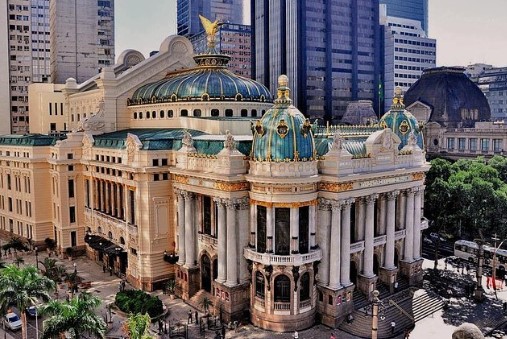
Rio also has four major football (soccer) teams and if you think you can go anywhere in town without somebody mentioning one or more of these then you are also kidding yourself. The teams are Flamengo, Fluminense, Botafogo and Vasco.




Rio is probably equally as famous for its Carnival. Usually in February, it begins on the Friday preceding lent and ends on Ash Wednesday, but the Winners’ Parade happens on the Saturday after carnival ends. Up until the mid 1980s, the Samba Parades of Rio Carnival were held along the main street of Avenida Presidente Vargas.
But 1984 saw the building of the permanent structure and stands that have come to be known as the Sambadrome Marquês de Sapucaí. This is a purpose-built stadium, designed specifically to host the annual parade and able to accommodate about 75,000 people.




The focus of Carnival is for the local Samba Schools to compete. The blurb says that the parades are an amalgamation of dance, fashion, music, narrative, spectacle, and competition in which thousands of performers process in the early morning hours through the Sambadrome.





Coming through in December we got to see the Sambadrome but obviously missed out on the February celebrations. The other thing that has tended to become a thing of ours is the taking in of local street art.









Due to the fact that it was New Year’s Eve and it was a cruise ship full of older people, the decision was made that the night would be more safely spent on the ship, rather than on the beaches of Brazil. So we all got ourselves back to the ship before dark and moved around to park in front of Copacabana Beach where we waited for the midnight fireworks show.









Everywhere we went in Brazil we constantly read about the safety situation. Even the Australian smart traveller website suggests that you exercise a high degree of caution in Brazil due to the threat of violent crime. This has not been our experience, everywhere we have been has been friendly and welcoming and has felt safe (granted we were not out and about in the evenings).
Brazil has been fun, friendly, incredibly well priced and will absolutely be somewhere that we will return to.
Iguaçu Falls
Iguazú Falls or Iguaçu Falls (depending on which country you are in) are waterfalls on the Iguazu River at the border of Argentina and Brazil. The falls are taller than Niagara Falls (in Canada) and wider than Victoria Falls (on the Zimbabwe/Zambia border). It is truly one of the most impressive waterfalls in the world and lives up to all the hype.


Some context

The falls are on the tri-border of Argentina, Brazil and Paraguay, however there is no views of the falls available from the Paraguay side.
Foz do Iguaçu is the Brazilian town of the tri-national region, bordering the Argentine city of Puerto Iguazú and the Paraguayan city of Ciudad del Este. Our trip saw us having 2 days on the Brazil side and 3 days in Argentina.
The semicircular waterfall is a bit over 80 m high and 2,700 m in diameter and is made up of many cascades producing vast sprays of water, it is one of the most spectacular waterfalls in the world. At one point along the edge of Iguacu Falls, an observer can stand and be surrounded by 260 degrees of waterfalls.
Around 80% of the falls are on the Argentinian side, while the remaining 20% is on the Brazilian side. The falls are made up of 275 individual waterfalls that drop water anywhere between 60 to 82 meters (depending on what they hit on the way down). In the local language (Guarani/Tupi) the word Iguazu means “big water”.
Foz do Iguacu
OK, so our first entry was into the Brazilian side and it must be said that Brazil is by far the most expensive of these three countries.
Our day trip to go to the falls cost us about $400 to do, but it did include a car to and from the park, all fees and even saw us on a boat ride getting soaked by the waters of the Iguaçu.
Looking on the map we got soaked by the Salto dos Mosqueteros and Salto Tres Mosqueteros.
Foz do Iguacu is a city of around 250-300,000 people and as you would expect, the majority of the town is geared around the falls. The tourism and transport sector is strong and the restaurants, shows and cafes also thrive here.




Anyway back to our trip, our car took us to the National Park where we hopped a bus for a 20 minute or so ride to the boat ride. From here we hopped an electric train thing (buggies pulled by a big golf cart) through the forest so as not to disturb the animals, where we got delivered at a rainforest walk that saw us hiking the last kilometer or so to get to the river for the boat ride.







From here you got changed (you were to be going under the waterfall and would be soaked) and left all your important gear in the lockers (for an additional fee). Then it was onto the short funicular down to the pontoons and onto one of the waiting boats. And this is where the fun starts. A quick 10 minutes or so up the river, through a series of about 4-6 rapids and all of a sudden the forest open up to expose the Argentinian side of the falls.






While only 20% of the falls are on the Brazilian side the best views can be found from the Brazil side as you get to see all of the falls. In addition to this, you actually get to walk out onto platforms over the bottom of the falls and get wet from the spray (more about this later).
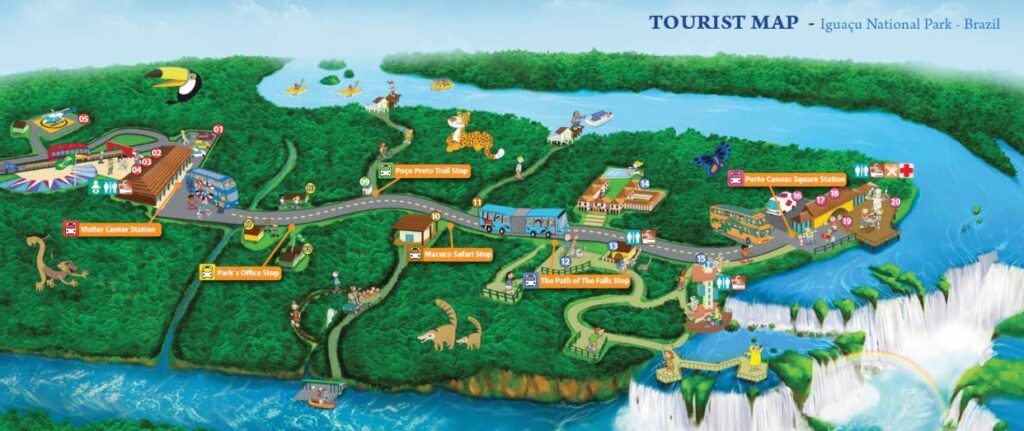
After the boat ride (and soaking) you go back to dry off, and get your things before taking a petrol jeep up the hill (too steep for the golf buggy) where you meet the electric cart, back through the forest and out onto the road again to wait for the next bus to take you to the next viewing point.
And what a spot to drop you off. Outside the Hotel das Cataratas, the closest hotels to the falls on the Brazilian side. Sadly our budget did not stretch to this.
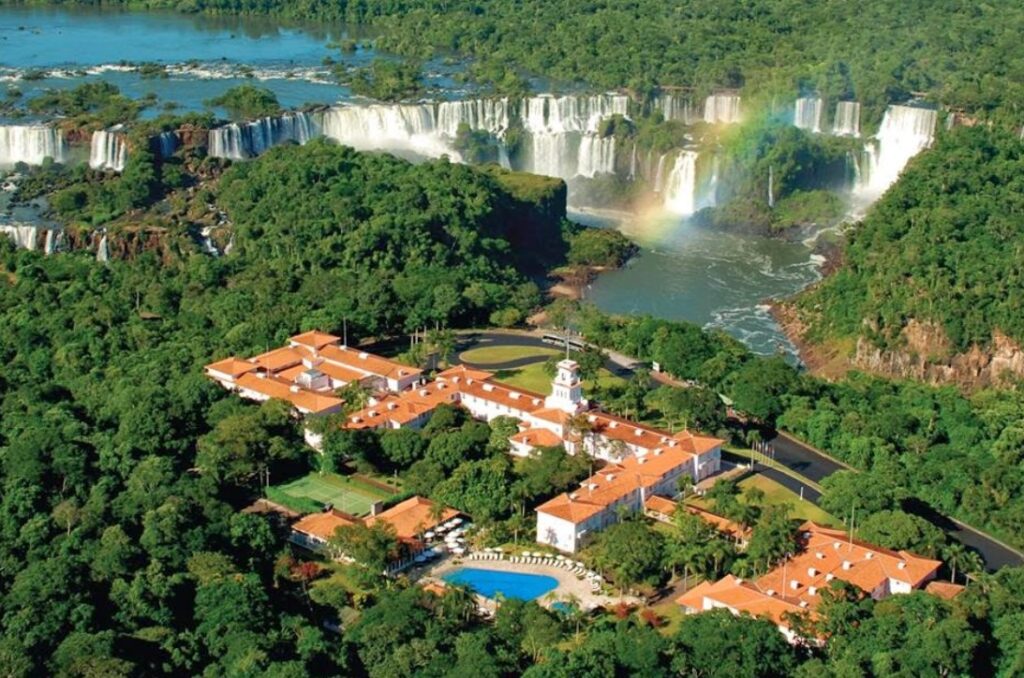
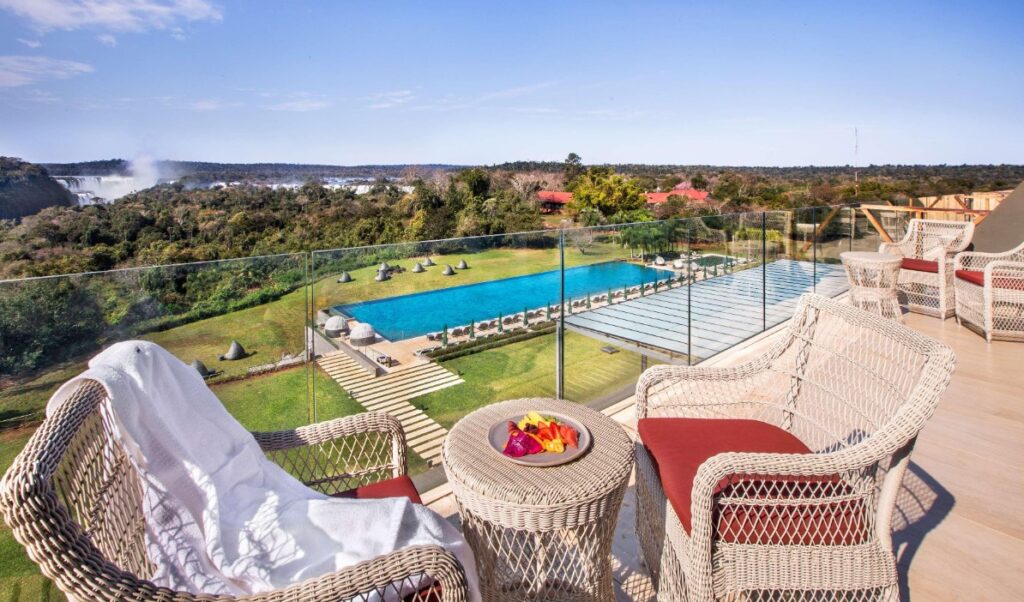
Not to be outdone, the Argentine side also has the Gran Meliá Iguazú. Needless to say, we didn’t stay here either.
From this point, you head down to a cliffside nature walk along the river where you get amazing photos of the Argentinian side (without the bumping and thumping of a moving boat). To say that this is amazing is an absolute understatement. Everywhere you look the angle changes and they are all stunning. Our photographs just kept clicking the whole time as every sight seemed somehow different.












This walk along the cliff takes you up and down stairs, along dodgy paths and will have your calves and thighs burning as this is a day that you will easily get your 10 thousand steps up (and many of them vertical).
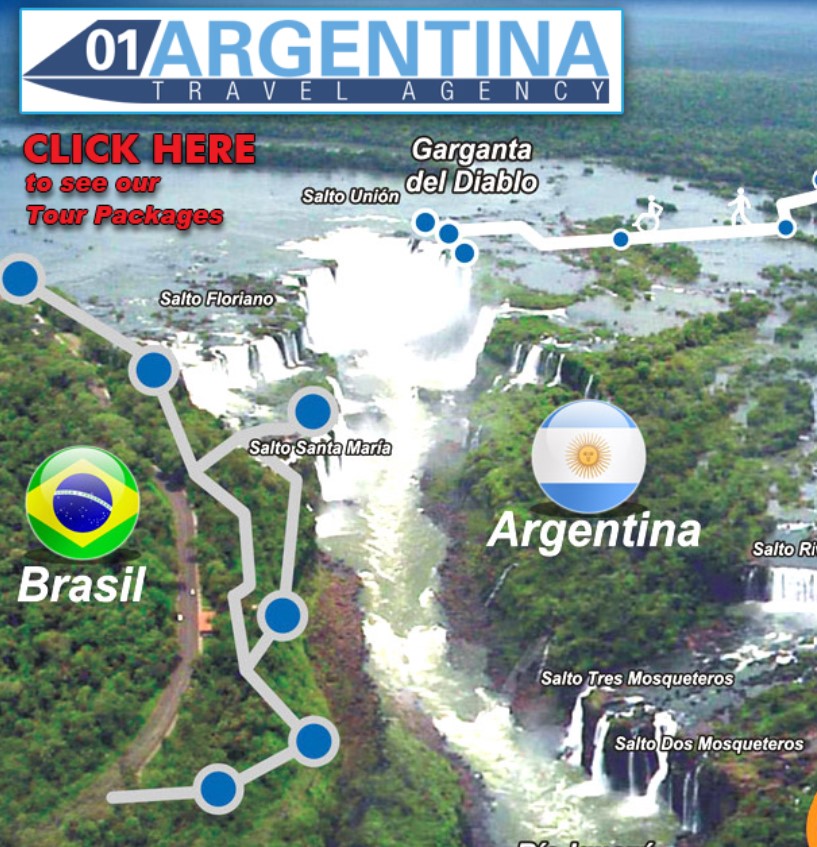
The path eventually spits you our at Salto Santa Maria which is the base of what would be considered the main falls. This area has a walkway over the top of the water and has amazing views of the biggest attraction, the devils throat (Garganta Del Diablo).

The legend
And of course, like any great natural feature, there has to be a local legend to explain its existence. In this instance the serpent god (M’Boi) was considered the God of the waters, protector of the river, nature and son of Tupã, the God of the Indians. But M’Boi fell in love with a local girl (Naipi) who was already engaged. He demanded that instead of marrying her fiancé (Taruba), she be sacrificed to him.

They decided to run away but M’Boi chased them and in a rage sliced the river, creating the falls and condemning the lovers.
Eventually, he transformed Naipi into a giant stone and Taruba into a tree on the other side of the falls, so that they would forever be apart.
A rainbow often forms from Taruba’s tree on the Brazilian side to Naipa’s rock on the Argentine side, which is said to symbolise their love.
However, the Serpent God is believed to still jealously watch the lovers from one of the deepest parts of the river, which is also known as the Devil’s Throat. Approximately one million litres of water per second is known to flow over the falls at the Devil’s Throat (or Devil’s Cauldron).
The Devil’s Throat is the most impressive of all of the 270 odd falls. It is a U-shaped cataract which has 14 falls plunging more than 350 feet. About half of the river’s flow falls into a long and narrow chasm. The canyon is 80–90 m wide and 70–80 m deep. It is estimated (by wiki) that almost 13 million litres of water flow over the falls every minute.







Having monstered the falls on the Brazilian side we had a night of Brazilian BBQ (cos you gotta do that) where too much meat is never enough. What we learned was that an all you can eat BBQ might have been fine in your 20’s, but in your 50’s it is too much of a stretch. After this we got ready for the ride over to the Argentinian side to check it out from over there.









